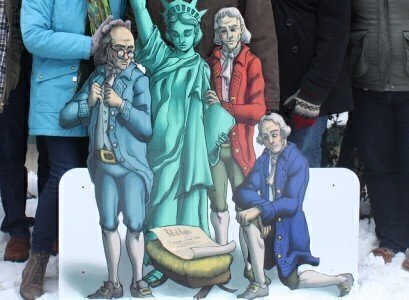As the December holiday season gets underway, it’s time for the annual debate over religious symbols appearing on public property. And this year, a nativity scene in several prominent locations will be replaced or joined by a Festivus pole and a Founding Fathers nativity.
 The Florida state capitol in Tallahassee has been the site of an ongoing debate over what kind of displays can mark the holiday season on the most public of public places. Last year, for example, in addition to a Nativity scene, a Christmas tree and a large Menorah, the state Department of Management Services allowed the aluminum Festivus pole (of “Seinfeld” fame), a diorama from the Satanic Temple and a holiday greeting from the Church of the Flying Spaghetti Monster. (The agency had denied the Satanic Temple’s request in 2013.)
The Florida state capitol in Tallahassee has been the site of an ongoing debate over what kind of displays can mark the holiday season on the most public of public places. Last year, for example, in addition to a Nativity scene, a Christmas tree and a large Menorah, the state Department of Management Services allowed the aluminum Festivus pole (of “Seinfeld” fame), a diorama from the Satanic Temple and a holiday greeting from the Church of the Flying Spaghetti Monster. (The agency had denied the Satanic Temple’s request in 2013.)
But as of this week, there were only two applications with the state for displays: for a 9-foot-high Menorah and a rainbow-colored gay pride Festivus pole.
Pam Olsen, the president of the Florida Prayer Network, said in a press release that her group is passing on the annual legal squabble over the displays.
“Some people misunderstand our freedoms in this nation, especially the freedom of a privately sponsored religious display in a government building. We are thankful that the Florida State Capitol is still an open forum. The Nativity is still welcome to be displayed in the Rotunda,” Olsen said, who also cited an incident last year where someone attacked the Satanic Temple display.
In Illinois, that state has approved the installation of a similar Festivus pole next to a nativity scene at the capitol. And in Grundy County, Illinois a display featuring the Founding Fathers gazing at the Bill of Rights in a manager will join religious and secular symbols on the courthouse lawn.
Likewise, in Indiana, the Freedom From Religion Foundation installed its Bill of Rights Nativity scene at the Franklin County Courthouse in late November. And the same display has been installed in an Ohio town.
The group also reports that someone stole a banner accompanying the constitutional creche at the Franklin County Courthouse; it is offering a reward for its return.
The presence of secular or diverse elements in a holiday display is at the heart of these First Amendment arguments, and it goes back to 1984, when the Supreme Court set its Plastic Reindeer Rule precedent.
In Lynch v. Donnelly from 1984, the Court was asked to consider if the First Amendment prohibited a municipality from including a creche, or Nativity scene, in its annual Christmas display. The holiday display in Pawtucket, Rhode Island, included the crèche along with other secular symbols such as a plastic reindeer, a Santa Claus house and a Christmas tree.
Chief Justice Warren Burger allowed the crèche to stay at the exhibit.
“If the presence of the creche in this display violates the Establishment Clause, a host of other forms of taking official note of Christmas, and of our religious heritage, are equally offensive to the Constitution,” Burger said. “We are satisfied that the city has a secular purpose for including the creche, that the city has not impermissibly advanced religion, and that including the creche does not create excessive entanglement between religion and government.”
Court observers at the time saw the presence of the reindeer as broadening the purpose of the display.
A second holiday-related decision in 1989 clarified the Court’s position on crèches. In County of Allegheny v. American Civil Liberties Union, the Court said in a 5-4 decision that of two public-sponsored holiday displays in Pittsburgh, Pennsylvania, only one was permissible.
Inside a courthouse the county had set up a crèche with a banner that read "Glory to God for the birth of Jesus Christ." It omitted a plastic reindeer, a Christmas tree or a Menorah. The Justices objected to that display.
A second display outside the Allegheny County courthouse featured a Menorah, a Christmas tree and a sign honoring Liberty. “We agree that the creche display has that unconstitutional effect, but reverse the Court of Appeals' judgment regarding the menorah display,” said Justice Harry Blackmun.
In her concurring Allegheny opinion, Justice Sandra Day O’Connor stressed what she meant in Lynch in what is known as the Endorsement Test.
“In my view, the central issue in Lynch was whether the city of Pawtucket had endorsed Christianity by displaying a creche as part of a larger exhibit of traditional secular symbols of the Christmas holiday season. In Lynch, I concluded that the city's display of a creche in its larger holiday exhibit in a private park in the commercial district had neither the purpose nor the effect of conveying a message of government endorsement of Christianity or disapproval of other religions. The purpose of including the creche in the larger display was to celebrate the public holiday through its traditional symbols, not to promote the religious content of the crèche.”
After the rulings in Lynch and Allegheny, the Court has mostly stayed out of cases involving the holiday season. It declined to hear cases involving a Menorah displayed by itself at a city park; a Menorah and crèche combined with Frosty the Snowman and Santa Claus; an attempt to have Christmas decertified as a federal holiday; and efforts to allow Christmas music to be played over the intercom at public schools.







